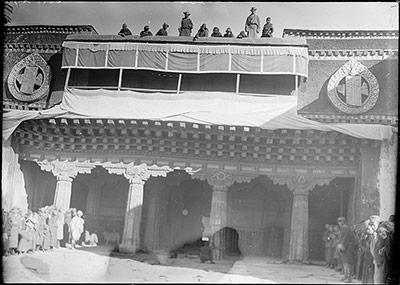
1998.285.290 (Glass negative)


1998.285.290 (Glass negative)

Rabden Lepcha?
Sir Charles Bell
June 14th 1921?
Lhasa > Jokhang
1998.285.290
120 x 163 mm
Negative glass plate gelatin , Negative Half Plate
Donated 1983
St Antony's College, Oxford.
Sir Charles Bell's Mission to Lhasa 1920-21
Royal Central Asiatic Society
Rabden Lepcha?
H.264
BL.H.264
Manual Catalogues - Bell's List of Illustrations entry: "[No. of chapter] L. [Subject of Chapter] Lhasa [Subject of Illustration] H.264 (ak) Main entrance to Tsuk Lakang; two gilt medallions above."
Other Information - Setting: Bell's Diary entry for 14th June 1921:"Neto Jongpen and I visit the Tsuk Lha-kang at 5.30pm. The repainting of the frescoes round the Nang-khor, describing events in previous lives of Buddha is in progress. We see some thrity artists at work, both monks and laymen. [ Insert in margin - Parkang Shape tells me that about 100 artists are employed altogether]. Women and children help by rubbing out the old frescoes, cleaning the walls etc. A head artist (Chi-kyap) is in charge of all the work and sees each artists work twice a daily so Neto says. [Insert in margin - Parkang Shape says that there is one chief teacher and 6 or 7 junior teachers under him. These supervise the work of the painters. The painters do not start painting a subject until one of the teachers has sketched in the outlines]. Per Neto "The pictures are first sketched in as regards their main figures and then painted over. These frescoes have not been repainted since the time of the 5th D[alai] L[ama]. [ The following has been crossed out from the entry: Now they are being done with European paints. Parkang Shape says that Tibetan, not European paints, are being used]." [Diary Vol. XI, p.5]
Other Information - Setting: Bell's Diary entry for 20th June 1921:" Per Tsendron "The frescoes in the Tsuk Lhakhang are being repainted now for the first time since the days of the 5th D[alai] L[ama]. The painters are all under a head, who holds the rank of Tse-trung. Indian and Tibetan paints are mixed for the blues and greens; Chinese paints are used for the reds, and Tibetan paints for the whites, yellows and blacks. Indian paints (perhaps European paints), if used alone do not last well." " [Diary Vol. XI, p.13]
For Citation use:
The Tibet Album.
"Jokhang temple, Lhasa"
05 Dec. 2006. The Pitt Rivers Museum.
<http://tibet.prm.ox.ac.uk/photo_1998.285.290.html>.
For more information about photographic usage or to order prints, please visit the The Pitt Rivers Museum.
© The Pitt Rivers Museum